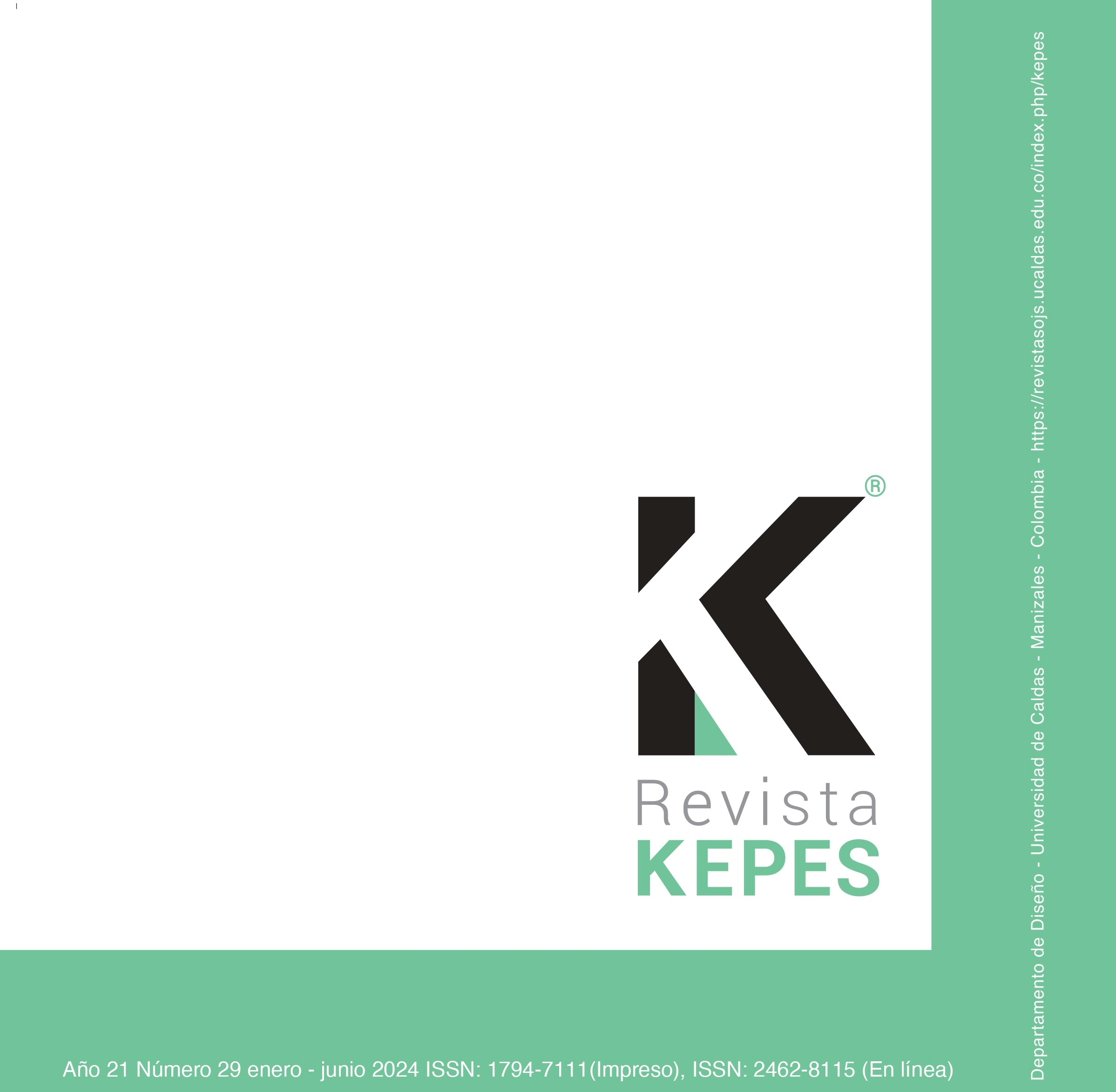Authors
Abstract
The phrase «Chile needs Industrial Design», engraved in 1972 on the façade of the Department of Industrial Design of Universidad de Chile in Valparaíso (DDI/Uch-Valpo), reflected the institutional commitment to national development. This article defined as the object of study of a university initiative of linkage and cooperation with society, namely the Graphic Projects Design Office (ODPG -for its acronym in Spanish)), specifically its production of posters between 1967 and 1973, a period of significant changes in Chile. The general objective was to describe and understand, from the disciplinary and professional concern of Design, the process and results of this graphic production, in the socio-cultural context of the time, as a way to rescue and revalue it. The qualitative and exploratory research used several methodological procedures: semi-structured interviews with four former students who made up the office, review and analysis of the production of 22 posters available from the collection, selection of a representative sample, semiotic-morphological analysis and its interpretation in a conceptual framework based on the socio-political and cultural context. Among the outstanding results are: (1) The role of the State and the University Reform as an explanatory context for this initiative to link with society and the role of the academy in a process of political and socio-cultural changes. (2) The ODPG emerged to satisfy cultural and social communication needs, involving academics and students, using industrial technology. (3) This technological and creative integration enriched academic training and prepared students for their professional practice in the industry. (4) The posters produced reflect the desire for social change, popular participation and cultural identity, influenced by socio-political movements such as the Cuban Revolution and the Ramona Parra Brigade. (5) The collection of posters is considered a historical testimony of the time and of the commitment of the university to society.
References
Barthes, R. (2017). Un mensaje sin código. Ensayos completos en Communications. Ediciones Godot.
Castañeda, M., Arévalo, R., Concha, C. y Castañeda, P. (2021). Conceptos y contextos de la extensión universitaria en Chile. InterCambios. Dilemas y transiciones de la Educación Superior, 8(2). http://www.scielo.edu.uy/scielo.php?script=sci_arttext&pid =S2301-01262021000200112
Castillo, E. (2008). La Escuela de Artes Aplicadas de la Universidad de Chile (1928-1968). En Actas de Diseño 5. Facultad de Diseño y Comunicación. Universidad de Palermo (pp. 31-248). https://dspace.palermo.edu/ojs/index.php/actas/article/view/3136/3883
Castillo, E. (2010a). Artesanos, Artistas, Artífices. La Escuela de Artes Aplicadas de la Universidad de Chile 1928-1968. Ediciones Ocho Libros.
Castillo, E. (2010b). Puño y letra. Movimiento social y comunicación gráfica en Chile. Ediciones Ocho Libros.
Castro, C., Labra, O. y Chamblas, I. (2022). El análisis de contenido temático. Una mirada a sus etapas desde Nvivo 12©. Revista Internacional de Ciencias Sociales Interdisciplinarias, 10(1), 143-158. https://revistas.unc.edu.ar/index.php/RIHALC/article/view/8357/9228
Copello, M. B. (2004). El afiche como paradigma de comunicación. Dialéctica entre Imagen y Texto en el afiche callejero de propaganda y cultural. Revista Huellas, 4, 112-116. http://bd.apps.sid.uncu.edu.ar/objetos_digitales/75/13Copello.pdf
Crow, D. (2008). No te creas una palabra. Una introducción a la semiótica. Promepress.
Del Huerto, M. A. (2018). La Reforma universitaria de Córdoba: pionera en el legado latinoamericano de universidad popular. Revista Cubana de Educación Superior, 1, 37-47.http://scielo.sld.cu/scielo.php?pid=S0257-43142018000100003&script=sci_abstract
Dondis, D. (1976). La sintaxis de la imagen. Introducción al alfabeto visual. Editorial Gustavo Gili.
Elam, K. (2014). La geometría del Diseño. Estudio sobre la proporción y la composición. Editorial Gustavo Gili, SL.
Fernández, S. y Bonsiepe, G. (2008). Historia del diseño en América Latina y el Caribe. Industrialización y comunicación visual para la autonomía. Editora Blücher.
Flores, J., García, E. y Rodríguez, G. (1996). Metodología de la investigación cualitativa. Editorial Aljibe.
Garvin, Ch. D., Gutiérrez, L. M. y Galinsky, M. J. (2017). Handbook of social work with groups.Guilford Publications. https://www.guilford.com/books/Handbook-of-Social-Work-with-Groups/Garvin-Gutierrez-Galinsky/9781462530588
Guerrero, Á. (2020). Imaginarios simbólicos del libertarismo revolucionario en Chile a partir de la gráfica, periodo 1970-1973 (tesis de grado). Universidad de Chile. https://repositorio.uchile.cl/handle/2250/179397
Joly, M. (2009). El análisis de la imagen: posibilidades y métodos. La marca editora.
Kelly, J. (17 de abril de 2012). El simbolismo del puño levantado. BBC. https://www.bbc.com/mundo/noticias/2012/04/120417_mano_cerrada_levantada_simbolismo
Leborg, Ch. (2013). Gramática visual. Editorial Gustavo Gili, SL.
Martínez, C. (1971). Bases para la estructura de un sistema universitario nacional chileno. Edeval.
Muratbekova, M. y Shamoi, P. (2024). Color-Emotion Associations in Art: Fuzzy Approach. IEEE Access, 12, 37937-37956. https://arxiv.org/abs/2311.18518
Nakajima, S. (2007). La universidad y la cultura nacional: historia de la extensión universitaria artístico-cultural en Chile. Ministerio de las Culturas, las Artes y el Patrimonio. http://observatorio.cultura.gob.cl/index.php/2021/09/22/la-universidad-y-la-cultura-nacionalhistoria-de-la-extension-universitaria-artistico-cultural-en-chile/
Poulin, R. (2012). El lenguaje del diseño gráfico. Conocimiento y aplicación práctica de los principios fundamentales del diseño. Promopress.
Rifo, M. (2019). ¿Modernización institucional o movimiento democratizador de la educación superior chilena? Una reinterpretación de la trayectoria previa a la dictadura civil-militar (1920-1973). Revista História da Educação (Online), 23, e78545. https://www.redalyc.org/journal/3216/321660471035/html/
Rivera, C. (2015). Diálogos y reflexiones sobre las comunicaciones en la Unidad Popular. Chile,1970-1973. Historia y comunicación social, 20(2), 345-367. https://dialnet.unirioja.es/servlet/articulo?codigo=5301495
Rodríguez-Plaza, P. (2003). El Chile de la Unidad Popular: Una mirada a la visualidad urbana de aquel tiempo. AISTHESIS: Revista Chilena de Investigaciones Estéticas, 36, 125-137. https://dialnet.unirioja.es//servlet/articulo?codigo=7009784
Ruder, E. (1983). Manual de diseño tipográfico. Editorial Gustavo Gili S.A.
Searle, J. (1994). Actos de habla. Editorial Planeta-Agostini.
Torres, I. (2009). La década de los setenta en Chile: La utopía como proyecto. HAOL, 19, 139-149. https://www.academia.edu/9602527/LA_DÉCADA_DE_LOS_SESENTA_EN_CHILE_LA_UTOPÍA_COMO_PROYECTO
Tünnermann, C. (1998). La reforma universitaria de Córdoba. Educación Superior y Sociedad, 9(1), 103-127. https://unesdoc.unesco.org/ark:/48223/pf0000115002
Universidad de Chile, Sede Valparaíso. (1970). Actas del Seminario de diseño industrial de Chile, Valparaíso. Departamento de diseño industrial, área de arte y tecnología 1970. Biblioteca Facultad de Arquitectura.
Vergara, E. y Garrido, C. (2011). Arte, poder y consumo en Chile: La gráfica como artefacto cultural entre 1970 y 1980. Revista 180, 28, 16-19. http://www.revista180.udp.cl/index.php/revista180/article/view/110/108
Vergara-Leyton, E. Garrido-Peña, C. y Undurraga-Puelma, C. (2014). La gráfica como artefacto cultural. Una aproximación semiótica al cartel social en Chile. Arte, Individuo y Sociedad. 26.10.5209/rev_ARIS.2014.v26.n2.41469. https://www.researchgate.net/publication/276036891_La_grafica_como_artefacto_cultural_Una_aproximacion_semiotica_al_cartel_social_en_Chile
Vico, M. (2019). Todos juntos: Iconografía de la contracultura en Chile (1964-1974). Ediciones Fulgor.
Villafañe, J. (2003). Introducción a la teoría de la imagen. Ediciones Pirámide.

 PDF (Español)
PDF (Español)
 FLIP
FLIP






















